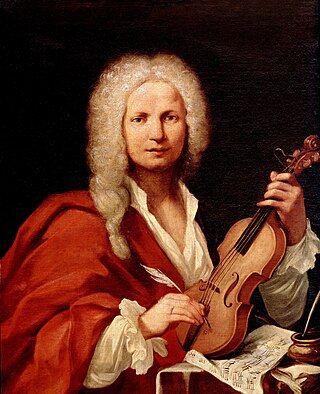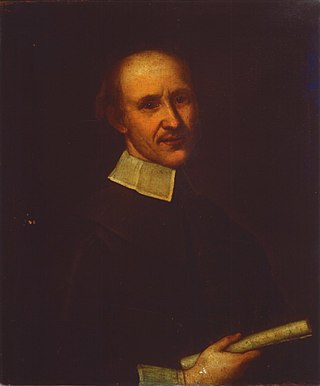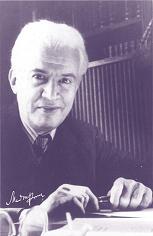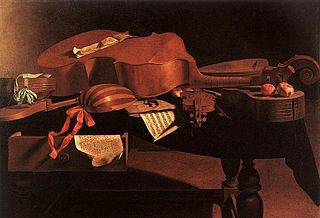Related Research Articles

Antonio Lucio Vivaldi was an Italian composer, virtuoso violinist and impresario of Baroque music. Along with Johann Sebastian Bach and George Frideric Handel, Vivaldi ranks amongst the greatest Baroque composers and his influence during his lifetime was widespread across Europe, giving origin to many imitators and admirers. He pioneered many developments in orchestration, violin technique and programmatic music. He consolidated the emerging concerto form into a widely accepted and followed idiom.

Domenico Alberti was an Italian singer, harpsichordist, and composer.

Tomaso Giovanni Albinoni was an Italian composer of the Baroque era. His output includes operas, concertos, sonatas for one to six instruments, sinfonias, and solo cantatas. While famous in his day as an opera composer, he is known today for his instrumental music, especially his concertos. He is best remembered today for a work called "Adagio in G minor", attributed to him but largely written by Remo Giazotto, a 20th century musicologist and composer, who was a cataloger of the works of Albinoni.

Giovanni Battista Draghi, usually referred to as Giovanni Battista Pergolesi, was an Italian Baroque composer, violinist, and organist, leading exponent of the Baroque; he is considered one of the greatest Italian musicians of the first half of the 18th century and one of the most important representatives of the Neapolitan school.

Arcangelo Corelli was an Italian composer and violinist of the Baroque era. His music was key in the development of the modern genres of sonata and concerto, in establishing the preeminence of the violin, and as the first coalescing of modern tonality and functional harmony.
The concerto grosso is a form of baroque music in which the musical material is passed between a small group of soloists and full orchestra. This is in contrast to the solo concerto which features a single solo instrument with the melody line, accompanied by the orchestra.
The trio sonata is a genre, typically consisting of several movements, with two melody instruments and basso continuo. It originated in the early 17th century and was a favorite chamber ensemble combination in the Baroque era.

Francesco Maria Veracini was an Italian composer and violinist, perhaps best known for his sets of violin sonatas. As a composer, according to Manfred Bukofzer, "His individual, if not subjective, style has no precedent in baroque music and clearly heralds the end of the entire era", while Luigi Torchi maintained that "he rescued the imperiled music of the eighteenth century", His contemporary, Charles Burney, held that "he had certainly a great share of whim and caprice, but he built his freaks on a good foundation, being an excellent contrapuntist". The asteroid 10875 Veracini was named after him.

Giuseppe Tartini was an Italian composer and violinist of the Baroque era born in Pirano in the Republic of Venice. Tartini was a prolific composer, composing over a hundred pieces for the violin, the majority of them violin concertos. He is best remembered for his Violin Sonata in G Minor.
Johan Helmich Roman was a Swedish Baroque composer. He has been called "the father of Swedish music" or "the Swedish Handel." He was the leader of the Swedish Royal Orchestra during the first decades of Sweden's Age of Liberty.

Giovanni Legrenzi was an Italian composer of opera, vocal and instrumental music, and organist, of the Baroque era. He was one of the most prominent composers in Venice in the late 17th century, and extremely influential in the development of late Baroque idioms across northern Italy.

Gaetano Pugnani was an Italian composer and violinist.
Giuseppe Francesco Gaspare Melchiorre Baldassare Sammartini was an Italian composer and oboist during the late Baroque and early Classical era. Although he was from Milan, most of his professional life was spent in London and with Frederick, the Prince of Wales. He also had a younger brother, Giovanni Battista Sammartini, who likewise became a renowned composer.

Manuel María Ponce Cuéllar, known in Mexico as Manuel M. Ponce, was a Mexican composer active in the 20th century. His work as a composer, music educator and scholar of Mexican music connected the concert scene with a mostly forgotten tradition of popular song and Mexican folklore. Many of his compositions are strongly influenced by the harmonies and form of traditional songs.

Cetra, a Latin word borrowed from Greek, is an Italian descendant of κιθάρα (cithara). It is a synonym for the cittern but has been used for the citole and cithara and cythara.

Tomaso Antonio Vitali was an Italian composer and violinist of the mid to late Baroque era. The eldest son of Giovanni Battista Vitali, he is chiefly known for a Chaconne in G minor for violin and continuo, to which he is traditionally attributed as the composer. The work was published from a manuscript in the Sächsische Landesbibliothek in Dresden in Die Hoch Schule des Violinspiels (1867) edited by German violinist Ferdinand David. That work's wide-ranging modulations into distant keys have raised speculation that it could not be a genuine Baroque work, while the lack of similarities to other works by Vitali have made modern scholars cast serious doubts on the attribution.
Giovanni Battista Vitali was an Italian composer and violone player.
[Domenico] Giovanni Antonio Pandolfi [Mealli] was an Italian composer and violinist.

Baroque music refers to the period or dominant style of Western classical music composed from about 1600 to 1750. The Baroque style followed the Renaissance period, and was followed in turn by the Classical period after a short transition. The Baroque period is divided into three major phases: early, middle, and late. Overlapping in time, they are conventionally dated from 1580 to 1650, from 1630 to 1700, and from 1680 to 1750. Baroque music forms a major portion of the "classical music" canon, and is widely studied, performed, and listened to. The term "baroque" comes from the Portuguese word barroco, meaning "misshapen pearl". The works of George Frideric Handel and Johann Sebastian Bach are considered the pinnacle of the Baroque period. Other key composers of the Baroque era include Claudio Monteverdi, Domenico Scarlatti, Alessandro Scarlatti, Alessandro Stradella, Tomaso Albinoni, Johann Pachelbel, Henry Purcell, Antonio Vivaldi, Georg Philipp Telemann, Jean-Baptiste Lully, Jean-Philippe Rameau, Marc-Antoine Charpentier, Arcangelo Corelli, François Couperin, Johann Hermann Schein, Heinrich Schütz, Samuel Scheidt, Dieterich Buxtehude, Gaspar Sanz, José de Nebra, Antonio Soler, Carlos Seixas and others.
Pierre Philibert de Blancheton was a French politician and music patron and collector. From 1724 until his death 30 years later he was a member of the Parliament of Metz.
References
- ↑ Willi Apel (1990). Thomas Binkley (ed.). Italian Violin Music of the Seventeenth Century (illustrated ed.). Indiana University Press. p. 151. ISBN 9780253306838.
- ↑ Tim Carter, John Butt, ed. (2005). The Cambridge History of Seventeenth-Century Music. Vol. 1. Cambridge University Press. p. 506. ISBN 9780521792738.
- ↑ Homer Ulrich (1966). Chamber Music (illustrated, reprint ed.). Columbia University Press. p. 48. ISBN 9780231086172.
- ↑ Maria Giovanna Fiorentino (1994). "Giovanni Antonio Leoni: nuove acquisizioni biografiche". Recercare. 6. Fondazione Italiana Per La Musica Antica (FIMA): 193–202. ISSN 1120-5741. JSTOR 41701192.